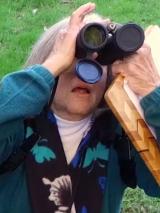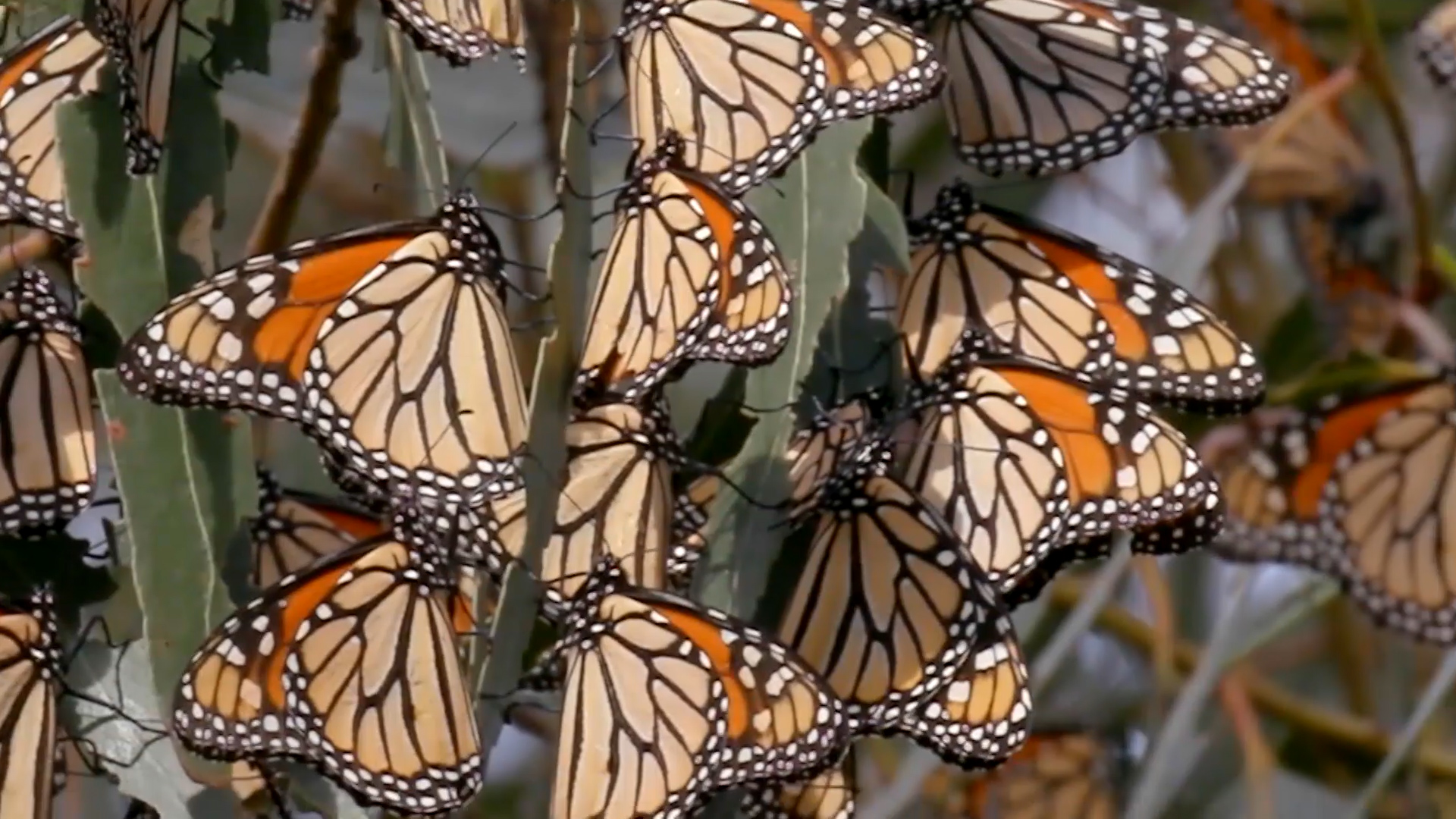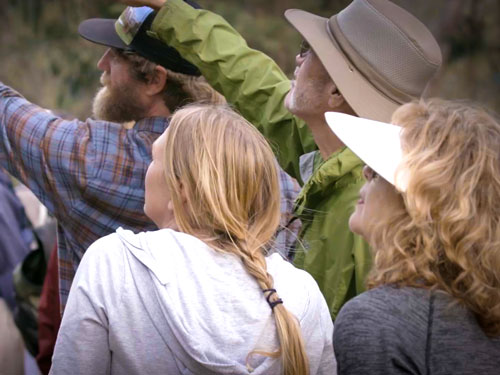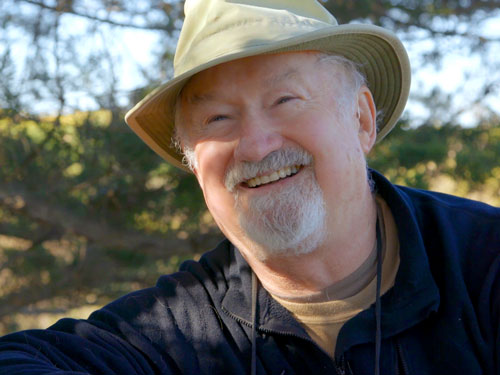
Newsletter
Sign up and stay in-the-know about The Crowd & The Cloud and the world of citizen science.


Cheryl Powers and Steven Thrasher are Western Monarch Count volunteers at the Pismo Monarch Butterfly Grove, Pismo Beach, California.
Why do the butterflies come to Pismo Grove?
Cheryl:
This area has been identified as an overwintering spot since the 1940s. It has an amphitheater of trees that protect the butterflies so they can get through the winter and have a great place to start the next generation. The butterflies start coming here in mid October. There are about 200 locations along the California coastline where the monarch butterflies overwinter. Pismo Grove happens to be one of their favorite places.

Monarch butterflies gather in the trees for warmth.
The butterflies are found in clusters in the eucalyptus or Monterey cypress trees, where the butterflies find protection and warmth in numbers. The monarchs that are overwintering here have never been to this part of California before. They travel on this journey to the California coastline to simply find the best possible microclimate for overwintering. Last year, we lost five, hundred-year-old trees in a big storm in January. We are afraid our numbers are going to be down a little bit at this particular location, but we hope the butterflies are going to be somewhere else if they're not here. The only way we’ll know, is by having people at other places counting the butterflies as well.
Steven:
It's funny, because you can go to places where there's huge eucalyptus groves, but there are no butterflies anywhere in the whole thing. They keep coming here, over and over. It’s because of the proximity to the ocean, the way the light is, the perfect humidity... it’s one special place they'll keep coming year after year. But places change. Trees fall down, land gets developed, and the butterflies may have to move somewhere else. Hopefully they'll keep coming.

Pismo Grove, California, is the "mothership" for over-wintering monarchs.
What is the Western Monarch Thanksgiving Count?
Steven:
The count is an initiative of the Xerces Society, an organization that keeps track of threatened species. They're trying to keep track of the population of the monarchs, so that they can promote better understanding of what it takes to keep the population stable or growing.
Cheryl:
Every year at the end of November for about a three week time period, volunteers survey monarch butterflies throughout California. Because there's been a 75% decline in the monarch population from their highest numbers in the 1990s, it is really important for us to know how the population is doing. We know that the drought in California has had a significant impact on the decline of the monarch population, as well as the loss of milkweed. It is the essential plant that the monarchs need in the rest of the year in order to bring them back again for overwintering.
Why do you volunteer to count butterflies?
Cheryl:
I've been a volunteer at the Pismo Monarch Butterfly Grove for five years. I started getting involved in the count when I began to process the reality of the decline in the population. I'm also a real believer in citizen science. I was a science teacher for almost 45 years, and it's fun to stay connected with science. Seems like a natural thing to be doing. There are citizen scientists all over the country that keep track of and support the restoration of the monarch butterfly population. It's a great opportunity for people who are lovers of nature, and who are concerned about preserving the environment.

Steven Thrasher: "Unless people get involved, you're just not going to have enough support."
The monarch butterflies are really like the canary in a coal mine. If the monarch butterfly population is going down, what else are we doing to nature? I feel empowered that the observations I’m making really can make a difference in understanding what's happening to this very important population.
Steven:
I started in support of Cheryl! Although, I was very much impacted the first time I went to a butterfly grove. We went to one in Santa Barbara where there were thousands of butterflies and they were all flying around. To me, things like that are an emotional experience, it really touches me to be able to see things like that in nature.
It's a way to support something that's really special. The way insects go through their life cycle is pretty amazing. They turn from an egg into some sort of caterpillar, or equivalent, and some of them go through a dormancy period like the butterflies do. Then, after this dormancy period, they come out something totally different. It is just amazing to see how something like that can transform. You think of an insect as being a fairly lower life form, but it is so amazingly complicated. Add to that this journey that the butterflies make through multiple generations. How in the world does something with a brain the size of a grain of sand figure that out? It's pretty amazing.
What is the process of counting like?
Cheryl:
When we count butterflies, we are recording the location, the number of individuals, exactly where they are in the trees, whether they’re sunning, or in clusters, and more. This information is all compiled by the Xerces Society. It's published nationwide around the first of the year. It contributes to our understanding of what's going on with the population of the western monarch butterfly. It's very valuable information for ecologists in trying to understand population fluctuations. Counting butterflies means going to locations where population clusters have been sighted in the past. You have to be willing to go out with your binoculars early in the morning.
Steven:
It's done in the morning because once they get warm enough to fly, it's impossible to count them! When it gets to 55 degrees, they start moving, and the warmer it gets after that, the more they're moving around.
Cheryl:
The counting method is basically like counting jelly beans in a jar. Sometimes, you can count the individual butterflies at the end of a branch. Other times, you simply have to estimate if it's a really big cluster.
Steven:
Most of the time, when they're densely packed, you count up to maybe ten in a group that's in a cluster of as many as a hundred or even more. Then, you count how many of those tens are in that particular cluster. You usually count in pairs. When you're going through this estimating process, you write down the average of the two counts. Sometimes that gets very confusing and complicated when you have trees with thousands of butterflies. We've had trees that have had as many as five thousand butterflies!
There was one year where they were particularly interested in height, because they were trying to map three dimensionally where these butterflies are residing. We're even monitoring temperature, light, and humidity as well. That's to help understand the microclimate that brings these butterflies to a specific location.

How do you describe the miracle of this migration?
Cheryl:
This is called the super generation of the monarch butterfly, they live six or eight months compared to the other generations of butterflies that only live six to eight weeks.
Steven:
When the butterflies mate, they go outwards across the western states. They go out and mate, and they lay their eggs which grow into caterpillars. Those caterpillars turn into butterflies that will continue on north and east, or they may stay there. Then, there'll be another generation going farther north and east, and yet another generation after that going further north and east. Then, the final generation makes the journey all the way back to a place that they've never been, and congregate here to protect themselves from the weather and predators. The fifth generation coming back to a place that they've never been is pretty remarkable, and we understand very little on how they do it.
What’s the importance of citizen science in projects like this?
Steve:
There's not enough money to pay people to do something like this. Unless people get involved, you're just not going to have enough support. If the state park were to try to run their programs without outside volunteers, they wouldn't be able to do what we're doing now. They wouldn’t be able to reach out to the public and get a whole bunch of people involved. Even people that don’t come back to volunteer again learn something and have more appreciation of what is going on here. I think anytime that you can promote knowledge of nature, that's going to promote the conservation of our natural areas.
